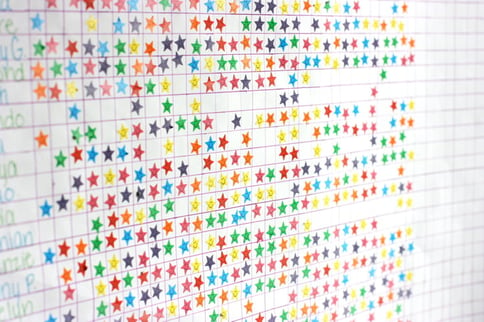Using Applied Behavior Analysis Interventions to Motivate the Classroom, Promote Cooperation, and Improve Behavior
You may have heard the phrase “ABA can save the world!” While Applied Behavior Analysis (ABA) works well on an individual basis, I have found that those same techniques and interventions also work well in the classroom. In fact, the use of ABA interventions in the classroom can promote cooperation, increase student attention, decrease disruptive behaviors, and motivate your entire class!
ABA in the Classroom
Although we usually hear the term ABA associated with autism, ABA can be applied in any setting or environment where behaviors need to be reduced, managed, or improved. ABA strategies can be successfully implemented in the classroom for any student or group of students exhibiting problem behaviors. Some of these behaviors may include:
- Inattentiveness or lack of patience
- Seeking attention through disruptive behaviors
- Fidgeting or hyperactivity
- Disrespect for other students and/or teachers
- Poor social skills
- Difficulty with transitioning to other tasks
- Elopement, such as getting out of one’s seat or even leaving the class
- Tantrums, destructive behaviors, and/or aggression
Teachers who are equipped to handle these challenging behaviors not only have less stress but also have more control over their classroom and better relationships with their students.
Understanding Behavior – The ABCs
All behavior has a purpose or a function, and before we can change a behavior, we need to understand why it is happening. As a teacher, you may be familiar with the ABCs of applied behavior analysis: the antecedent, the behavior, and the consequence. Before we can try to increase or decrease a behavior, we need to determine the antecedent, or what is causing the behavior. In ABA, we refer to this as the “function” of the behavior. If we do not identify the function, then we are basically guessing.

Implementing ABA Strategies in the Classroom
Two ABA strategies I commonly recommend for classroom use are token economies and group contingencies. Token economies provide tokens, or rewards, for appropriate behaviors that can be exchanged for a desired item or privilege. The teacher provides a token, for example, a coin, a star, or a sticker, each time the student displays a desired behavior. In addition, the teacher may also have a list of undesirable behaviors that cause a student to lose a token. A group contingency is when a teacher sets a common expectation, such as remaining seated and quiet during quiet work, and reinforces a small group of students or an entire class.
Advantages of a Token Economy
There are many different ways to use a token economy in the classroom. Advantages of token economies include:
- The reinforcement of positive behavior
- Targets specific behaviors
- Consistent reminders of goals
- Leads to behavior change
- The students receive both immediate and delayed reinforcement
- Promotes fair exchanges, math skills, and economics
Seven Steps to Implementing a Token Economy
1. Determine the target behavior
In a classroom setting, this may include remaining seated or quiet, completing assignments, putting things away, or possibly more severe behaviors, such as yelling or even hitting.
2. Choose the tokens to be used
Tokens should be simple, colorful, attractive, inexpensive, reusable, difficult to duplicate, easy to maintain, and simple to secure or transport.
 3. Select the rewards
3. Select the rewards
These rewards can be obtained by trading in the tokens, which may include stickers, toys, extra playtime, or other enjoyable activities.
4. Determine the reinforcement schedule
This is an important step because while you want to increase desired behaviors, the optimal goal is to slowly decrease the frequency of the tokens and awards.
5. Determine the exchange criterion
This is the number of tokens required to obtain a given reward. The token "pricing" should be appropriate, fair, and attainable to maintain student motivation.
6. Specify a time and place for token exchange
Set rules so that students only exchange tokens at a specified time and place.
7. Implement a loss of token penalty (optional)
This is an optional step, commonly referred to as a response cost component, where a token may be lost, which can be attached to behaviors such as hitting or throwing items.
The Group Contingency
A group contingency may be independent, dependent, or interdependent. An independent group contingency would be presented to all of the students, but reinforcement, such as extra recess, is only given to the students who meet the requirements of the contingency. A dependent contingency is when reinforcement is given to the entire class but is dependent on one student or a small group. I try to avoid this type of contingency in the classroom because it tends to hinder inclusion, which can cause further disruption. An interdependent group contingency is when all of the students in the class meet the requirements of the contingency before any students receive reinforcement. For example, each student will need to remain quiet during quiet work before any of the students receive extra recess.
Five Steps to Implementing an Effective Group Contingency
There are a few key components when implementing a group contingency strategy in the classroom.
- First, you want to determine the function of the behavior.
- Second, you want to select which group contingency strategy is most appropriate based on the severity of the behavior, how many students are engaging in the behavior, the dynamics of your class, the skills of the students, and your goals for behavior change.
- Third, be sure to select powerful reinforcers appropriate for the entire class. Your students may enjoy extra recess time, extra time in the computer lab, a favorite snack, or maybe a favorite game at the end of the day.
- Fourth, you will want to set appropriate performance requirements and expectations of the contingency so that they are simple and understandable, “stating the rules.”
- Continue to implement the contingency! Be sure to provide the students with plenty of feedback and monitor your results to ensure your strategy is effective.

Here Are Some Additional Tips
-
Modify the environment
Visual support is extremely helpful in the classroom. For instance, is a hyperactive child who is easily distracted sitting next to the window? Is a child diagnosed as autistic sitting directly under a bright lightbulb or a loud vent? Is the classroom organized and labeled? -
Provide consistency
If you are stating an expectation or a demand, you should be prepared to enforce it. When implementing strategies, be consistent in implementation AND reinforcement. In other words, make sure you actually leave time to play that game at the end of the day! -
Be open to change
When monitoring your plan, you may notice that it is not as effective as you thought it would be. That is okay! More than likely, it is not the fault of the student, but a problem within the contingency plan itself. Review your plan and make adjustments as needed!

Marianne Coppola
Marianne Coppola, MHA, ABA works as a child development specialist with toddlers and pre-schoolers. She is passionate about early intervention and finding creative and engaging ways to help children reach developmental milestones. Her work extends to children diagnosed with Autism Spectrum Disorder, Attention Deficit Hyperactivity Disorder, Sensory Processing Disorder, Social Anxiety, and Motor Development Delays. She holds an M.A. in Healthcare Administration, and an M.A. in Special Education and Applied Behavior Analysis. She is currently studying to become a Board-Certified Behavior Analyst and is pursuing a PhD in Behavioral Health.




